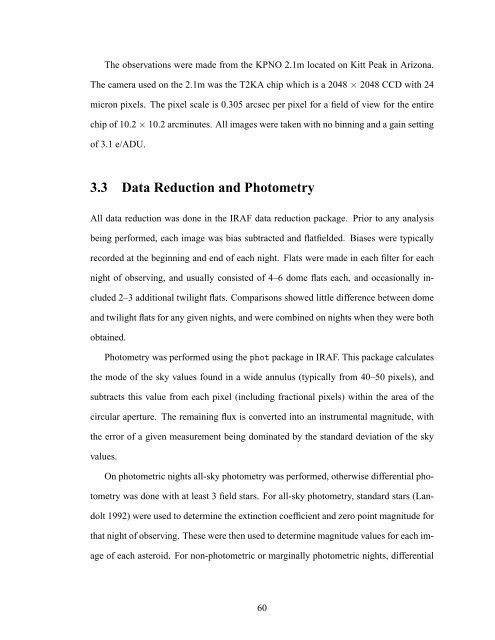Forming Binary Near-Earth Asteroids From Tidal Disruptions
Forming Binary Near-Earth Asteroids From Tidal Disruptions
Forming Binary Near-Earth Asteroids From Tidal Disruptions
You also want an ePaper? Increase the reach of your titles
YUMPU automatically turns print PDFs into web optimized ePapers that Google loves.
The observations were made from the KPNO 2.1m located on Kitt Peak in Arizona.The camera used on the 2.1m was the T2KA chip which is a 2048 × 2048 CCD with 24micron pixels. The pixel scale is 0.305 arcsec per pixel for a field of view for the entirechip of 10.2 × 10.2 arcminutes. All images were taken with no binning and a gain settingof 3.1 e/ADU.3.3 Data Reduction and PhotometryAll data reduction was done in the IRAF data reduction package. Prior to any analysisbeing performed, each image was bias subtracted and flatfielded. Biases were typicallyrecorded at the beginning and end of each night. Flats were made in each filter for eachnight of observing, and usually consisted of 4–6 dome flats each, and occasionally included2–3 additional twilight flats. Comparisons showed little difference between domeand twilight flats for any given nights, and were combined on nights when they were bothobtained.Photometry was performed using the phot package in IRAF. This package calculatesthe mode of the sky values found in a wide annulus (typically from 40–50 pixels), andsubtracts this value from each pixel (including fractional pixels) within the area of thecircular aperture. The remaining flux is converted into an instrumental magnitude, withthe error of a given measurement being dominated by the standard deviation of the skyvalues.On photometric nights all-sky photometry was performed, otherwise differential photometrywas done with at least 3 field stars. For all-sky photometry, standard stars (Landolt1992) were used to determine the extinction coefficient and zero point magnitude forthat night of observing. These were then used to determine magnitude values for each imageof each asteroid. For non-photometric or marginally photometric nights, differential60












